Rigid-flex circuit boards rely on a combination of material properties to guarantee reliable performance and durability. Dielectric constants, thermal conductivity, flexural rigidity, and electrical insulation are critical factors. Materials like Polyimide, PTFE, and Ceramic-filled PTFE offer varying dielectric constants, while high thermal conductivity materials like aluminum and copper facilitate efficient heat dissipation. Flexural rigidity and strength, as well as material fatigue and flexibility, are also essential considerations. By understanding these material properties, designers can create high-performance rigid-flex PCBs. Further exploration of these properties will uncover more nuances and optimize design decisions.
Key Takeaways
- Dielectric constant values of materials like FR4, Polyimide, and PTFE impact signal integrity in rigid-flex PCBs.
- Thermal management relies on high thermal conductivity materials like aluminum, copper, and thermally conductive dielectric materials.
- Flexural rigidity and strength analysis is crucial for reliable performance, influenced by Young's modulus and flexural modulus values.
- Polyimide film is renowned for its exceptional thermal stability, chemical resistance, and durability in rigid-flex PCBs.
- Material properties like electrical insulation, chemical resistance, and thermal management are critical for maintaining performance and durability.
Material Selection Criteria
When designing rigid-flex circuit boards, choosing the ideal material is essential, as it directly impacts the board's reliability, manufacturability, and electrical performance. Material selection for rigid-flex PCBs is based on factors such as reliability requirements, manufacturing methods, cost considerations, and electrical performance needs. The chosen material must possess specific properties that guarantee the board's functionality and durability.
Polyimide, for instance, is a preferred material for rigid-flex PCBs due to its toughness, resistance to movement, elevated temperature capabilities, and low coefficient of thermal expansion. The selection of adhesives is also critical, as they play a crucial role in ensuring secure connections between materials. Adhesives must exhibit high temperature resistance, flexibility, and chemical stability to guarantee the board's reliability.
The combination of substrate materials, conductors, adhesives, and protective coatings in rigid-flex PCBs is critical to achieving the desired performance, reliability, and durability in electronic applications. By carefully considering material properties and selection criteria, designers can create high-performance rigid-flex PCBs that meet the demands of modern electronics.
Effective material selection is essential for ensuring the overall success of rigid-flex PCBs in a wide range of applications.
Dielectric Properties Analysis
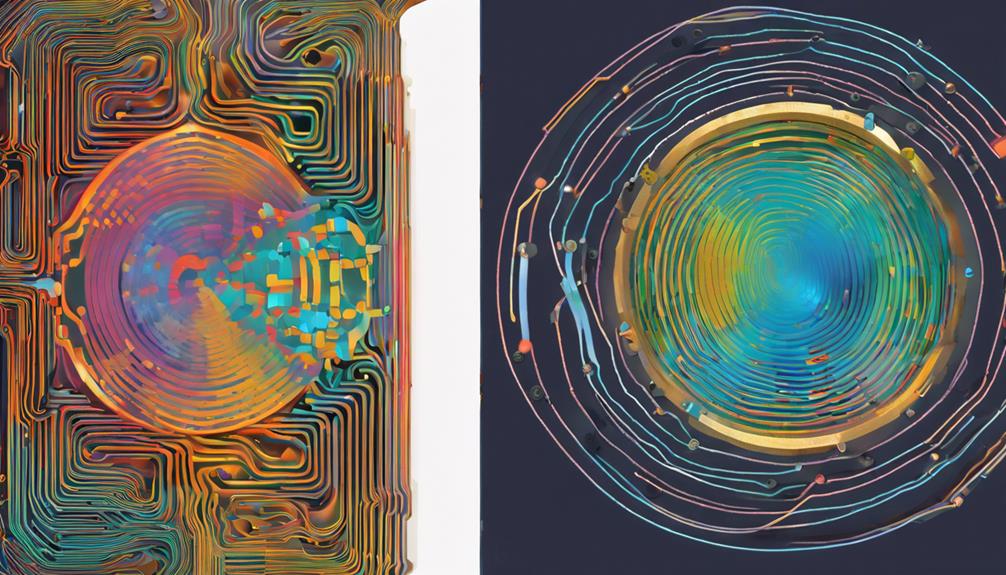
In the context of rigid-flex circuit boards, dielectric properties analysis is essential for optimizing signal integrity. Specifically, dielectric constant values, material signal loss, and frequency dependence analysis are key aspects to examine.
Dielectric Constant Values
Dielectric constant values, a critical aspect of a material's dielectric properties, play a pivotal role in determining the performance of a rigid-flex circuit board. These values indicate the material's ability to store electrical energy in an electric field, making them a vital factor in material selection for ideal signal integrity.
When it comes to material selection, low dielectric constants are desirable for reduced signal loss and improved signal integrity. However, materials with high dielectric constants are used for impedance control and signal propagation in specific applications. Understanding dielectric constant values is essential for designing high-performance and reliable rigid-flex circuit boards.
| Material | Dielectric Constant Value | Applications |
|---|---|---|
| FR4 | 4.3-4.5 | General purpose PCBs |
| Polyimide | 3.5-4.5 | Flexible circuits, high-reliability applications |
| PTFE | 2.1-2.2 | High-frequency, high-power applications |
| Ceramic-filled PTFE | 2.5-3.5 | High-frequency, high-power applications |
Material Signal Loss
Material signal loss, a critical aspect of dielectric properties analysis, heavily impacts the performance and reliability of rigid-flex circuits during high-frequency signal transmission.
The dielectric properties of materials have a substantial impact on signal loss, making material selection essential for ideal signal performance. A lower dielectric constant material reduces signal loss and improves signal integrity, making it an important consideration in material selection.
The dissipation factor, also known as the loss tangent, indicates a material's ability to dissipate electromagnetic energy as heat. Materials with low dissipation factors are preferred for high-frequency applications to minimize signal loss. A low dissipation factor ensures that the signal remains strong and unaffected by the material's properties.
Understanding dielectric properties is critical in selecting materials for ideal signal performance in rigid-flex circuits. By considering the dielectric constant and dissipation factor, designers can choose materials that minimize signal loss, ensuring reliable and high-performance rigid-flex circuits.
Frequency Dependence Analysis
As signal frequencies increase, understanding how dielectric properties vary with frequency becomes essential to maintaining signal integrity and minimizing losses in rigid-flex circuit boards.
Frequency dependence analysis of dielectric properties is vital for guaranteeing top performance and reliability in high-frequency applications. By analyzing how dielectric properties change with frequency, designers can select materials that meet specific performance requirements, minimizing signal loss and ensuring signal integrity.
Data on dielectric constant and loss tangent at various frequencies provides valuable insights into material behavior, enabling the selection of materials with stable dielectric properties across a wide frequency range. This is particularly important in high-frequency applications, where signal integrity is critical.
Analyzing dielectric properties at different frequencies ensures that rigid-flex circuit boards perform reliably in diverse electronic applications. By understanding how dielectric properties vary with frequency, designers can optimize circuit design, minimize signal loss, and maintain signal integrity, resulting in improved overall performance and reliability.
Thermal Management Characteristics
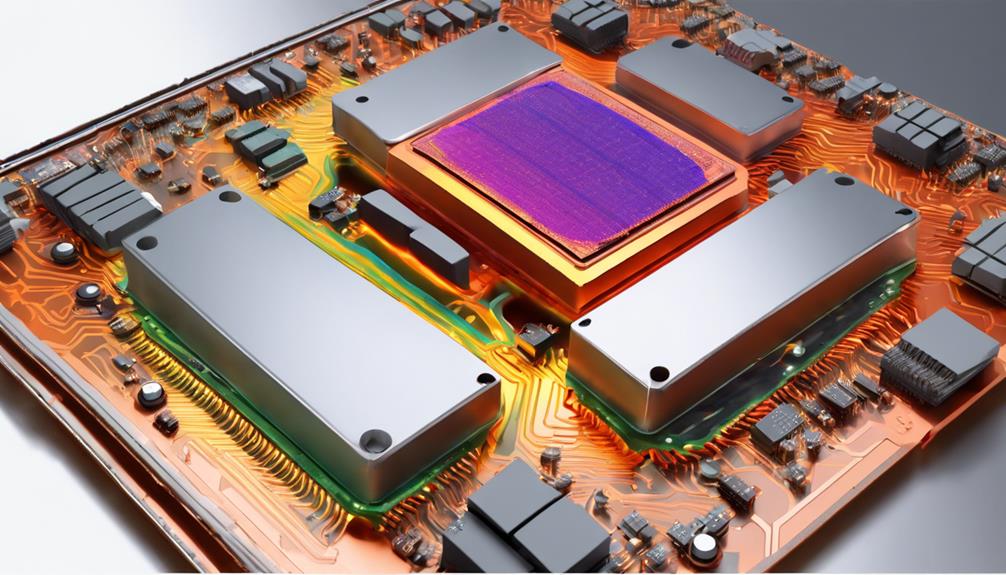
Efficient thermal management in rigid-flex circuit boards is essential, as excessive heat generation can lead to compromised performance, reduced lifespan, and even catastrophic failure.
To mitigate this, rigid-flex circuit boards utilize high thermal conductivity materials like aluminum or copper, which efficiently dissipate heat. Thermally conductive dielectric materials in rigid-flex PCBs also play a critical role in managing heat generated by components.
Additionally, thermal vias and heat sinks integrated into the design enhance thermal management in rigid-flex circuits. Proper thermal management in rigid-flex PCBs prevents overheating and ensures peak performance.
The thermal resistance and heat resistance of these materials are critical factors in managing heat dissipation. Copper traces, which have low thermal resistance, are often used to facilitate heat transfer.
Advanced thermal modeling software can simulate heat dissipation in rigid-flex circuit boards, allowing for efficient design optimization. By carefully selecting materials and designing thermal management strategies, rigid-flex circuit boards can maintain peak performance and reliability.
Flexural Rigidity and Strength
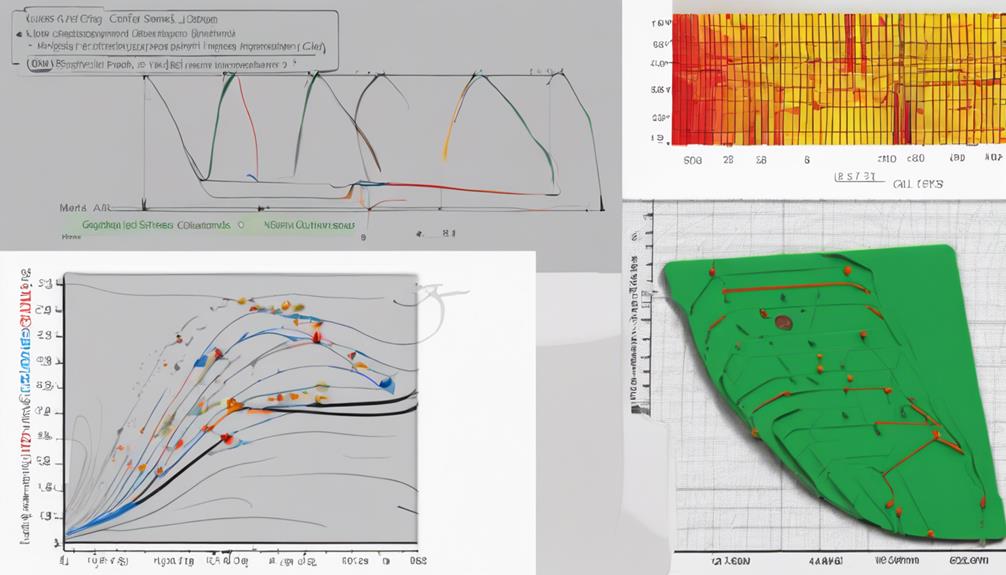
In the context of rigid-flex PCBs, understanding flexural rigidity and strength is vital for ensuring the board's structural integrity.
A thorough analysis of bending stress, flexural modulus values, and material fatigue life is essential to determine a material's suitability for a specific application.
Bending Stress Analysis
Rigid-flex circuit boards, by their very nature, are prone to bending stress, making rigorous analysis of flexural rigidity and strength a critical step in ensuring reliable performance.
Bending stress analysis in rigid-flex circuits involves evaluating flexural rigidity, which determines the board's resistance to bending. Flexural strength is also vital in gauging how much stress the board can withstand before permanent deformation occurs.
Material properties, such as Young's modulus and thickness, greatly influence flexural rigidity and strength in rigid-flex circuit boards. A thorough understanding of bending stress enables design engineers to optimize material selection and board layout for reliable performance.
Flexural Modulus Values
Building on the importance of bending stress analysis, material properties such as flexural modulus values play a vital role in determining the flexural rigidity and strength of rigid-flex circuit boards. Flexural modulus values indicate the stiffness and resistance to bending of a material, with higher values implying greater rigidity and less flexibility.
In the context of rigid-flex PCB designs, understanding flexural modulus values is essential for selecting materials that can withstand bending stress without compromising the integrity of the circuit board.
Polyimide, a common material used in flex PCBs, has a flexural modulus of around 2,800-3,000 MPa, making it a suitable choice for applications requiring flexibility and durability. The flexural strength of a material, which measures the maximum stress it can withstand before breaking under bending, is also closely related to its flexural modulus.
Material Fatigue Life
Material fatigue life, which determines the number of bend cycles a rigid-flex PCB can withstand, is a critical factor in designing durable circuits for long-term reliability. The ability of a material to resist cracking and breaking under repeated bending is a key consideration in material selection. Polyimide materials, in particular, are preferred for their high flexural strength and fatigue resistance, making them an ideal choice for rigid-flex circuits.
Understanding material fatigue properties is essential in designing durable rigid-flex circuits that can withstand the rigors of repeated bending and flexing. Proper material selection and design considerations can greatly enhance the fatigue life of rigid-flex circuit boards. By selecting materials with high flexural rigidity and strength, designers can create circuits that can endure the stresses of repeated bending and flexing, ensuring long-term reliability and performance.
In rigid-flex PCB design, material fatigue life is a critical factor in determining the overall durability and reliability of the circuit. By understanding the material fatigue life of different materials, designers can make informed decisions about material selection and design considerations, ultimately leading to the creation of high-performance, reliable rigid-flex circuits.
Electrical Insulation Performance
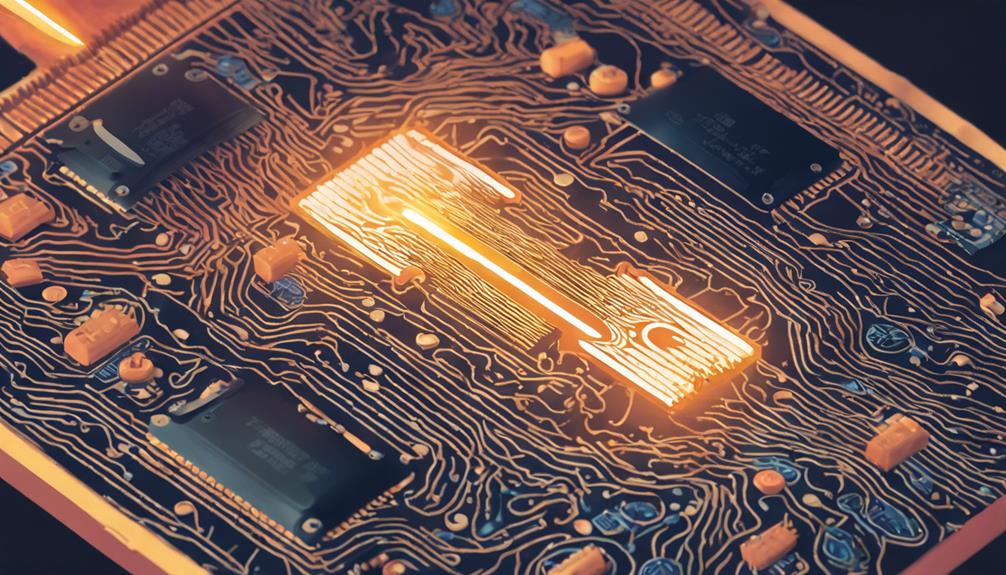
In high-reliability applications, the electrical insulation performance of rigid-flex circuit boards is vital to preventing short circuits and ensuring signal integrity.
The choice of material plays a critical role in achieving top-notch electrical insulation performance. Polyimide film, a commonly used material in rigid-flex circuits, offers exceptional electrical insulation properties. Its high dielectric strength enables it to withstand high temperatures and voltage levels, making it an ideal material for demanding applications.
The electrical insulation performance of polyimide film ensures reliable operation in extreme environments with minimal risk of electrical failures. By selecting materials with superior electrical insulation properties, the reliability and performance of rigid-flex circuit boards can be greatly enhanced.
This is particularly important in high-reliability applications where signal integrity is paramount. By leveraging the excellent electrical insulation properties of polyimide film, designers can create robust and reliable rigid-flex circuits that meet the most stringent performance requirements.
Chemical Resistance and Durability

When it comes to chemical resistance and durability, the choice of material is crucial in guaranteeing the reliability and longevity of rigid-flex circuit boards.
The chemical compatibility of materials such as polyimide and polyester is vital in preventing degradation and damage from exposure to harsh chemicals and environments.
Chemical Compatibility
Rigid-flex circuit boards owe their exceptional chemical resistance to the inherent properties of polyimide and PTFE, which provide a robust defense against corrosive substances and solvents. The polyimide-based rigid-flex boards exhibit high durability against various chemicals and solvents, ensuring long-term reliability and performance in challenging conditions. PTFE materials, in particular, offer outstanding chemical compatibility, making them ideal for harsh environments.
The chemical resistance of rigid-flex PCB materials is critical for maintaining structural integrity and functionality in chemically aggressive settings. This property enables the boards to withstand exposure to corrosive substances, ensuring continued performance and reliability.
The durability of rigid-flex circuit board materials is essential for withstanding the rigors of harsh environments, where chemical compatibility is paramount. By leveraging the inherent properties of polyimide and PTFE, rigid-flex circuit boards can operate reliably in demanding conditions, making them an attractive choice for a wide range of applications.
Material Longevity
Five key factors contribute to the exceptional material longevity of rigid-flex circuit boards. The inherent chemical resistance and durability of polyimide and polyester materials play a crucial role in this longevity. These properties enable rigid-flex PCBs to withstand harsh environments and guarantee long-term reliability.
The chemical resistance of materials like polyimide and polyester is a critical factor in material selection. It directly impacts the lifespan of rigid-flex PCBs. Additionally, the durability of these materials ensures that the PCBs can withstand mechanical stress and other forms of wear and tear.
Some key benefits of rigid-flex PCBs' material longevity include:
- Enhanced lifespan in various applications
- Resistance to corrosion and degradation
- Reduced risk of material failure and malfunction
Adhesive Bonding and Laminating
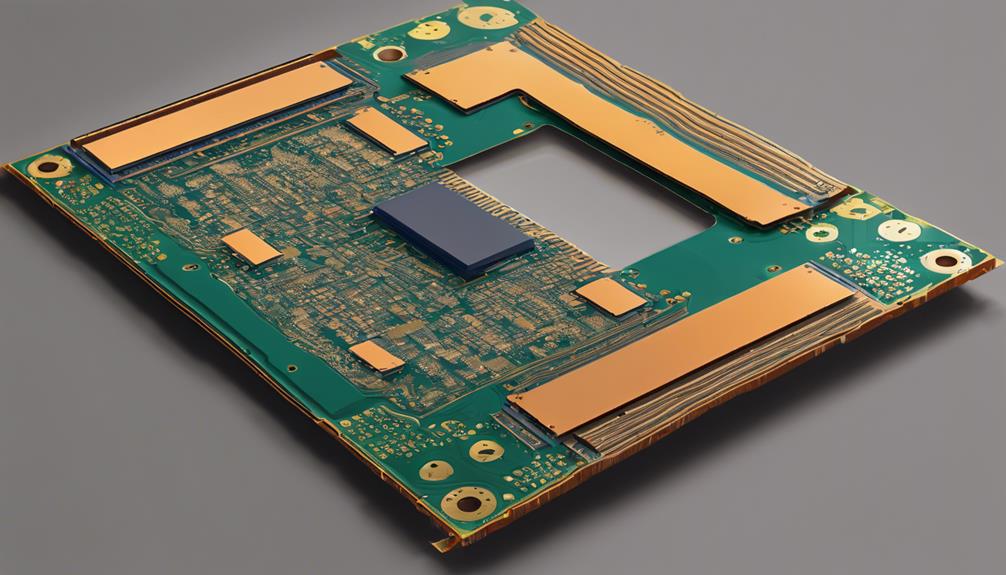
In the fabrication of rigid-flex PCBs, adhesive bonding and laminating processes play a vital role in guaranteeing the secure connection of various layers and components. Adhesive bonding involves the use of materials like polyimide, polyester, acrylic, and epoxies to create strong bonds between layers.
Laminating processes, on the other hand, secure the bonding of layers such as substrates, conductive materials, and protective coatings.
Adhesives play an essential role in rigid-flex PCB construction, providing mechanical reinforcement and insulation between layers. Different types of adhesives offer varying temperature resistance, flexibility, and chemical resistance properties, making proper selection essential for ensuring the reliability, durability, and performance of rigid-flex circuit boards.
The choice of adhesive can significantly impact the overall performance of the PCB, and incorrect selection can lead to compromised connections and reduced lifespan.
Copper Clad Laminate Properties
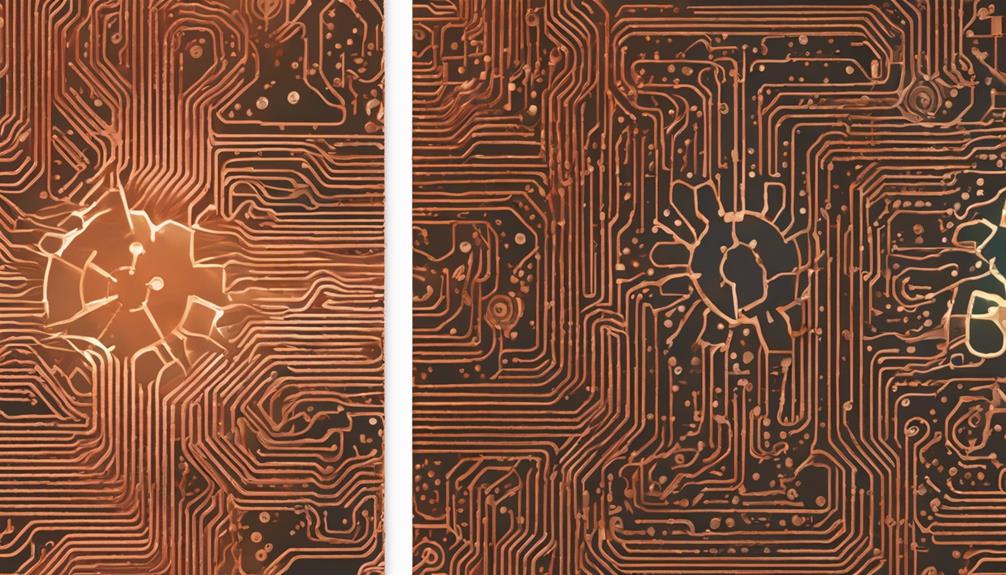
Bonding copper foil to a substrate material forms a copper clad laminate, an essential component in rigid-flex PCB construction that offers a range of benefits and design considerations. The copper clad laminate is a critical component that provides the necessary electrical conductivity and mechanical strength for high-reliability applications.
Key characteristics of copper clad laminates include:
- Varying copper foil thickness (1 oz to 3 oz) for adjustable conductivity
- Excellent thermal conductivity for high-power applications
- Dependence of flexibility and durability on copper foil choice
The quality of the copper foil used in copper clad laminates greatly impacts the electrical performance and signal integrity of rigid-flex PCB designs. High-quality copper foil ensures reliable electrical performance, making it a crucial factor in the design and manufacturing of rigid-flex circuits.
Polyimide Film Characteristics
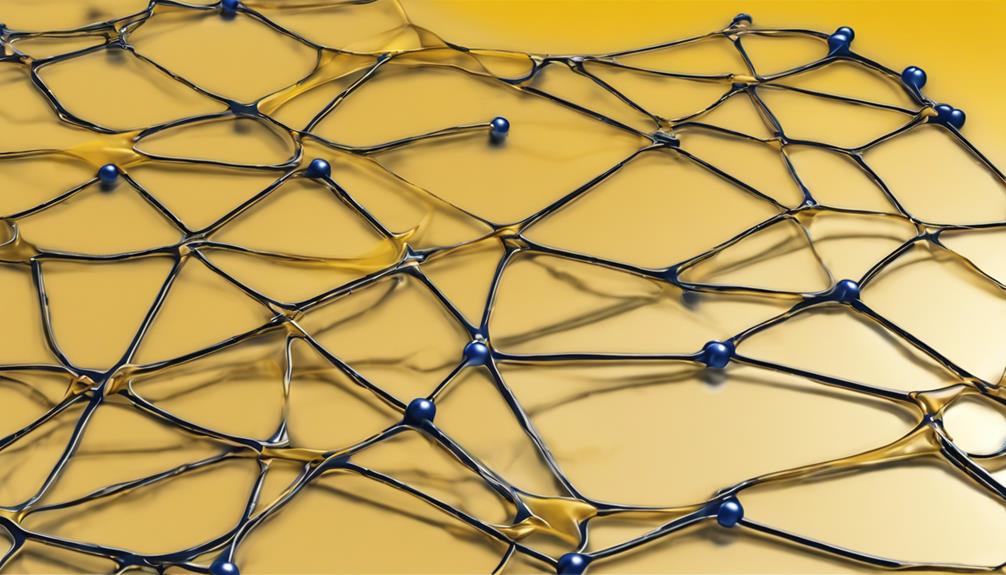
Polyimide film, a material renowned for its exceptional flexibility, toughness, and heat resistance, is a popular choice for rigid-flex PCBs, offering a unique combination of properties that enhance the longevity and reliability of circuit boards.
The material properties of polyimide film make it an ideal selection for applications demanding high performance and durability. Its low coefficient of thermal expansion ensures that it remains stable under temperature variations, making it suitable for applications where thermal stress is a concern.
In addition to its thermal stability, polyimide film provides excellent chemical resistance, an important property for protecting circuits in harsh environments. This property guarantees that the material maintains its integrity even when exposed to corrosive substances, thereby safeguarding the circuitry.
The mechanical properties of polyimide film also make it suitable for applications requiring high performance and durability. By leveraging the exceptional material properties of polyimide film, designers and manufacturers can create high-reliability rigid-flex PCBs that excel in demanding environments.
PTFE and PEEK Material Options

What sets PTFE and PEEK apart from other rigid-flex circuit board materials is their exceptional performance in extreme environments and specialized applications. These premium materials are known for their reliability, durability, and performance in demanding situations.
PTFE offers a wide temperature range (-200°C to 260°C) and exceptional stability in harsh environments, making it an ideal choice for high-frequency applications due to its low dielectric constant and low dissipation factor.
PEEK, on the other hand, provides excellent chemical resistance, high heat tolerance (up to 260°C), and mechanical strength, making it a preferred material in demanding industries like aerospace and medical for its resistance to chemicals, radiation, and wear.
Some key benefits of PTFE and PEEK material options include:
- Exceptional performance in extreme temperatures and harsh environments
- High reliability and durability in specialized applications
- Resistance to chemicals, radiation, and wear in demanding industries
Stiffener Materials and Design

Rigid-flex circuit boards rely on strategically placed stiffener materials to reinforce areas with components or terminations, thereby enhancing overall mechanical strength and thermal stability. These stiffener materials, such as polyimide, FR4, and aluminum, provide support to areas prone to mechanical stress, guaranteeing the reliability and longevity of the circuit board. The stiffeners enhance the mechanical strength, thermal stability, and reliability of rigid-flex circuits, making them an essential component of the design.
When designing rigid-flex circuits, stiffener materials must be carefully selected and placed to guarantee optimal performance. Design considerations include the thickness, placement, and compatibility of the stiffener materials with the PCB materials. The flexible and rigid portions of the circuit board must be carefully balanced to ensure that the stiffener materials provide the necessary support without compromising the flexibility of the board.
Proper selection and placement of stiffener materials are critical to guaranteeing the integrity of rigid-flex circuit boards. By carefully considering the design requirements and material properties, designers can create reliable and high-performance rigid-flex circuits that meet the demands of modern electronic systems.
Coatings and Surface Finishing

As the rugged environments and harsh conditions in which rigid-flex circuit boards operate necessitate additional protection, coatings and surface finishing play a vital role in ensuring the reliability and longevity of these circuit boards.
Coatings provide a barrier against environmental factors such as moisture, dust, and chemicals, while surface finishing enhances solderability, conductivity, and resistance to corrosion.
Some common surface finishes for rigid-flex PCBs include:
- HASL (Hot Air Solder Leveling)
- ENIG (Electroless Nickel Immersion Gold)
- OSP (Organic Solderability Preservative), an environmentally friendly and cost-effective option
The surface finishing process is essential in ensuring the reliability and longevity of rigid-flex circuit boards in various applications. By applying a suitable coating and surface finish, rigid-flex PCBs can withstand harsh operating conditions, ensuring excellent performance and extended lifespan.
The right combination of coatings and surface finishing can make a significant difference in the overall performance and reliability of rigid-flex PCBs.
Reliability and Failure Analysis

Ensuring the reliability of rigid-flex circuit boards is critical to maintaining their performance and durability over time. Failures can have significant consequences in various applications. To achieve this, failure analysis techniques are employed to identify and rectify issues such as delamination, solder joint failures, and electrical connectivity problems.
Environmental factors, mechanical stress, and thermal cycling can all impact the reliability of rigid-flex circuit boards, making it essential to understand the material properties that influence their performance. Advanced testing methods, including thermal cycling, bend testing, and microsection analysis, are used to assess reliability and identify areas for improvement.
Frequently Asked Questions
What Materials Are Used in Rigid-Flex Pcb?
In the construction of rigid-flex PCBs, a range of materials are employed. Polyimide and polyester are commonly used as substrate materials, offering flexibility and durability.
Copper, in electro-deposited and rolled foil forms, serves as the preferred conductor material.
Adhesives like polyimide, polyester, acrylic, and epoxies facilitate bonding, while protective coatings, including coverlays and cover coats, provide insulation and protection.
What Is the Base Material of a Flex Pcb?
The base material of a flex PCB is typically polyimide, a flexible and heat-resistant polymer. This material is chosen for its exceptional toughness, durability, and high-temperature resistance, ensuring reliability and longevity in diverse electronic devices.
Polyimide provides the necessary flexibility for bending and folding in flex PCBs without compromising performance, making it an ideal material for a wide range of applications.
What Is the Difference Between Rigid and Flex Pcb?
Like a sculptor chiseling marble, the choice between rigid and flex PCBs requires precision and deliberation.
Rigid PCBs, with their inflexible materials, offer stability and sturdiness, making them ideal for traditional electronics.
In contrast, flex PCBs, with their flexible substrates, provide agility and adaptability, perfect for compact or wearable devices.
The distinction lies in their material properties, with rigid PCBs prioritizing stability and flex PCBs embracing flexibility.
What Are the Characteristics of Rigid Pcb?
Rigid Printed Circuit Boards (PCBs) are characterized by their inflexibility, providing a stable foundation for electronic components and connections. They are composed of solid, non-flexible materials, typically reinforced with woven fiberglass and epoxy resin.
This rigidity guarantees a sturdy base for mounting components, making them suitable for applications where bending or flexing is not required. The non-flexible base material offers a reliable platform for electronic devices that do not necessitate flexibility.


